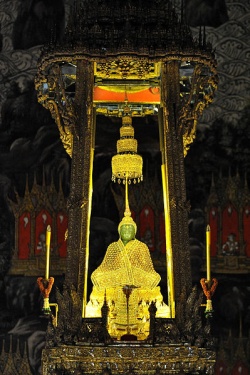Emerald Buddha
The Emerald Buddha (Thai: พระแก้วมรกต – Phra Kaeo Morakot, or official name พระพุทธมหามณีรัตนปฏิมากร – Phra Phuttha Maha Mani Rattana Patimakon) is the palladium (Thai: ขวัญเมือง khwan mueang; colloquially มิ่งเมีอง ming mueang) of the Kingdom of Thailand, a figurine of the sitting Buddha, made of green Nephrite (rather than emerald), clothed in gold, and about 45 cm tall. It is kept in the Temple of the Emerald Buddha (Wat Phra Kaew) on the grounds of the Grand Palace in Bangkok.
History
According to the legend, the Emerald Buddha was created in India in 43 BC by Nagasena in the city of Pataliputra (today's Patna). The legends state that after remaining in Pataliputra for three hundred years, it was taken to Sri Lanka to save it from a civil war. In 457, King Anuruth of Burma sent a mission to Ceylon to ask for Buddhist scriptures and the Emerald Buddha, in order to support Buddhism in his country. These requests were granted, but the ship lost its way in a storm during the return voyage and landed in Cambodia. When the Thais captured Angkor Wat in 1432 (following the ravage of the bubonic plague), the Emerald Buddha was taken to Ayutthaya, Kamphaeng Phet, Laos and finally Chiang Rai, where the ruler of the city hid it. Cambodian historians recorded capture of the Buddha statue in their famous Preah Ko Preah Keo legend. However, some art historians describe the Emerald Buddha as belonging to the Chiang Saen Style of the 15th century AD, which would mean it is actually of Lannathai origin.
Historical sources indicate that the statue surfaced in northern Thailand in the Lannathai kingdom in 1434. One account of its discovery tells that lightning struck a pagoda in a temple in Chiang Rai, after which, something became visible beneath the stucco. The Buddha was dug out, and the people believed the figurine to be made of emerald, hence its name. According to a less fanciful explanation, "emerald" here simply means "green coloured" in Thai. King Sam Fang Kaen of Lannathai wanted it in his capital, Chiang Mai, but the elephant carrying it insisted, on three separate occasions, ongoing instead to Lampang. This was taken as a divine sign and the Emerald Buddha stayed in Lampang until 1468, when it was finally moved to Chiang Mai, where it was kept at Wat Chedi Luang.
The Emerald Buddha remained in Chiang Mai until 1552, when it was taken to Luang Prabang, then the capital of the Lao kingdom of Lan Xang. Some years earlier, the crown prince of Lan Xang, Setthathirath, had been invited to occupy the vacant throne of Lannathai. However, Prince Setthathirath also became king of Lan Xang when his father, Photisarath, died. He returned home, taking the revered Buddha figure with him. In 1564, King Setthathirath moved it to his new capital at Vientiane.
In 1779, the Thai General Chao Phraya Chakri put down an insurrection, captured Vientiane and returned the Emerald Buddha to Siam, taking it with him to Thonburi. After he became King Rama I of Thailand, he moved the Emerald Buddha with great ceremony to its current home in Wat Phra Kaew on 22 March 1784. It is now kept in the main building of the temple, the Ubosoth.
Gold clothing
The Emerald Buddha itself is simply the Jadeite statue, but it is adorned with garments made of gold. There are three different sets of gold clothing, which are changed by the King of Thailand or a liaison in a ceremony at the changing of the seasons – in the 1st Waning of lunar months 4, 8 and 12 (around March, July and November). The three sets of gold garments correspond to Thailand's summer season, rainy season, and cool season. The two sets of gold clothing not in use at any given time are kept on display in the nearby Pavilion of Regalia, Royal Decorations and Thai Coins on the grounds of the Grand Palace, where the public may view them.
